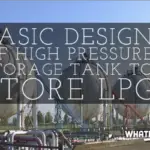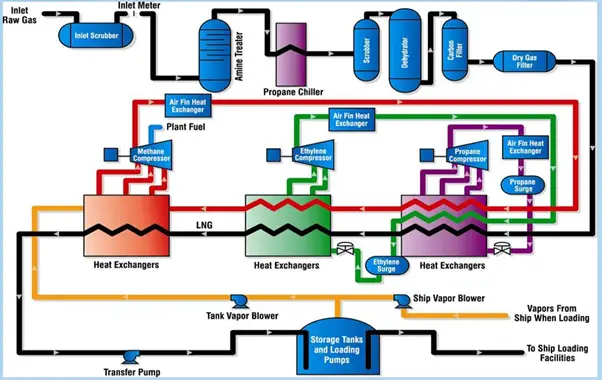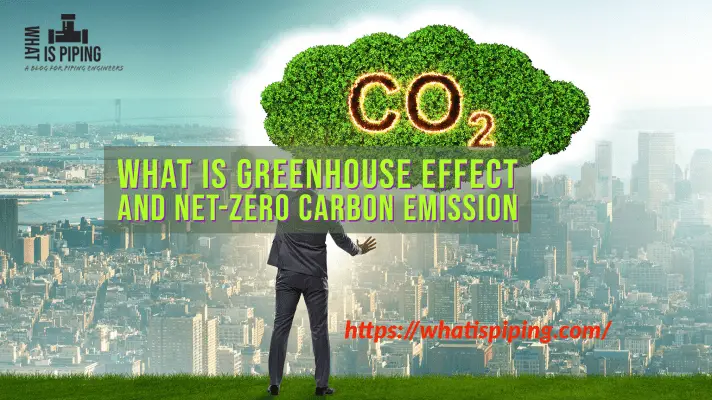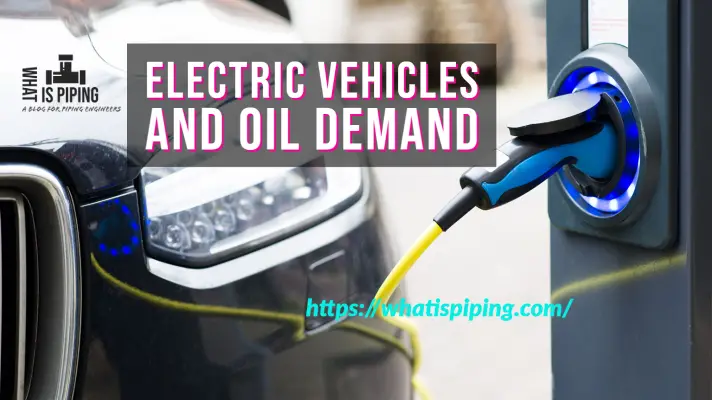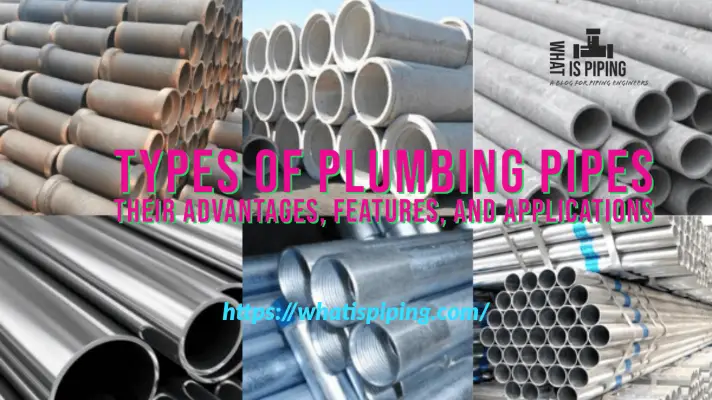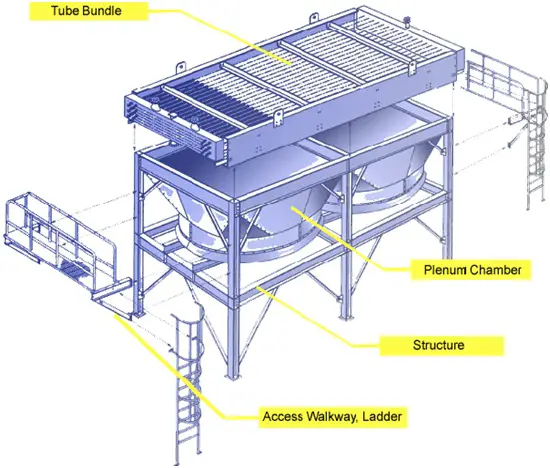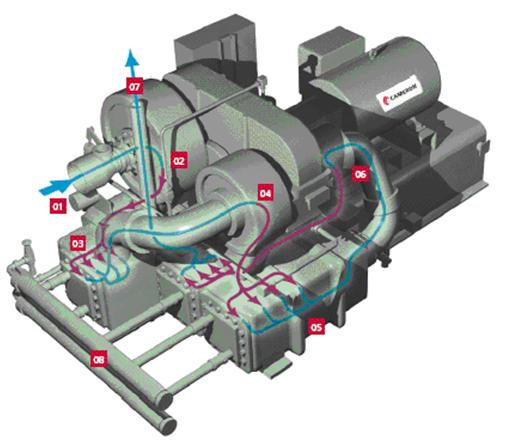Liquefied Petroleum Gas, commonly known as LPG, plays a vital role in our daily lives, offering a clean, efficient, and reliable source of energy for various applications. Whether it’s for cooking in households, fuel for vehicles, or even heating homes and businesses, LPG is an indispensable fuel globally. Liquefied Petroleum Gas or LPG is a non-renewable source of energy. It is the backbone of cooking, transport, heating, and industry for millions of people worldwide. It is an outstanding upgrade to air quality, efficiency, and climate friendliness as compared to other traditional fuels. It is a responsible source of energy.
The name sounds a bit contradictory as to how something can be both gas and liquid. Because the first one can fly in the air and the second one can splash in a pool. In simple terms, if you see, you will find LPG as a gas under normal pressure and temperature in your living room or garden. But it changes into liquid form when put under pressure or it is cooled down.
What is Liquified Petroleum Gas (LPG)?
LPG is a group of hydrocarbon gases, primarily propane (C₃H₈) and butane (C₄H₁₀), that are compressed into a liquid form for ease of storage and transportation. These gases are naturally occurring in crude oil and natural gas deposits or are produced during the refining of crude oil. In its liquid form, LPG occupies much less space than in its gaseous state, making it convenient to store in pressurized containers.
Liquefied Petroleum Gas is extracted from crude oil and natural gas. It is composed of hydrocarbons containing some carbon atoms, maybe three or four. It is a flammable mixture containing hydrocarbon gases Propane (C3H8) and butane (C4H10) are the normal components of liquefied petroleum gas. Other hydrocarbons in small concentrations may also be present. It is a flammable mixture containing hydrocarbon gases that are used as fuel in heating appliances, vehicles, and cooking equipment. It contains 48 percent propane, 50 percent butane, and 2 percent pentane.

Varieties of LPG that are bought and sold include mixes that contain mostly propane and butane and also sometimes include mixes of both propane and butane. In the areas of the northern hemisphere winter, mixes of more propane are found whereas, in summer, it contains more butane.
Two grades of LPG are sold in the United States mainly commercial propane and HD-5. Other hydrocarbons such as Propylene and butylenes are also present in small concentrations such as ethane (C2H6), methane (CH4), and propane (C3H8). A powerful odorant known as ethanethiol is added to LPG so that leaks can be detected easily. EN 589 is the internationally recognized European standard. In Australia, liquefied petroleum gas is just propane. In other words, all LPG is not propane but propane is LPG.
Liquefied petroleum gas has an energy content similar to petrol and twice the heat energy of natural gas and it burns readily in the air which makes LPG an excellent fuel for cooking, heating, and automotive use.
Where does Liquefied Petroleum Gas come from?
It all starts with nature. Liquefied petroleum gas was first found in 1910. It was then found that petroleum, diesel, gasoline, and heating oil also contain LPG and this was discovered by the American chemist Dr. Walter O. Snellling. Propane and butane are naturally occurring which make up an LPG.
The majority of liquefied petroleum gas is recovered during oil and natural gas extraction while the remaining 40% is made from waste or renewable vegetable oils or is a co-product of oil refining. As LPG is a fossil fuel, it comes from oil and gas wells. Liquefied petroleum gas is stored in liquid form in a steel container, tank, or cylinder under pressure. The pressure inside the container is dependent on the type of LPG used, be it commercial propane or commercial butane, and the outside temperature.
The Production Process of LPG
LPG is either extracted during the refining of crude oil or as a byproduct from natural gas processing. Here’s a breakdown of the production process:
- Natural Gas Processing: When natural gas is extracted from the earth, it contains several components, including methane, propane, butane, and other gases. The heavier hydrocarbons like propane and butane are separated from the methane (the main component of natural gas) through a process called fractionation.
- Crude Oil Refining: During the refining of crude oil, LPG is produced as a byproduct when refining heavier hydrocarbons into lighter products like gasoline and diesel. It’s separated out during the distillation process.
Once produced, LPG is stored in large tanks or transported in pressurized cylinders to various consumer and industrial sectors.
Characteristics of Liquefied Petroleum Gas
There are some of the features of LPG that make it unique on its own.
- When petroleum gas changes from a gaseous to a liquid state, it shrinks significantly. It becomes easy to transport lots of energy in a small space as the volume of the liquid is only 1/250 of the gas.
- When the liquid inside the cylinder is heated up or when we release the pressure by opening the valve, the liquid changes into vapor form.
- The liquid which is turned into vapor is heavier than air. In the case where a cylinder or tank is leaking then it will first change into vapor and then slowly start spreading close to the ground.
- Chemically, liquefied petroleum gas is made up of propane, butane, or a mix of the two, and also it contains hydrogen and carbon atoms.
Why choose LPG?

There are several reasons why one should choose LPG and there are a thousand applications that run on LPG. The list is long and includes everything from hot air balloons to cars and heating and BBQs. In other words, it is an extremely versatile fuel. It is used all over the world by millions of people for different purposes with the same result.
The production of LPG globally has increased to 300 million tons per year. In the case where half of its demand comes from the domestic sector using the same for cooking or heating. There are several reasons why one should choose LPG and these are as follows:
Versatility
This is one of the outstanding qualities of LPG. It is one of the most flexible fuels without any comparison and due to its many applications, it is often referred to as a multipurpose form of energy.

Efficiency
LPG is packed with energy. It is extremely efficient. As compared to other energy fuels such as petrol, diesel, coal, and natural gas, it is richer in energy. It has a higher calorific value. In other words, when you set an LPG on fire, the flame temperature will be drastically higher as compared to other fuels which means this results in higher efficiency with a rising temperature.
As compared to other traditional fuels, LPG is five times more efficient. Hence using an LPG makes it the best way to use most of the planet’s resources. LPG’s high efficiency is one of the most unparallel advantages for both planet and people which makes it one of the best reasons to choose. LPG always keeps its power for good whereas other traditional fuels deteriorate over a period of time.
Easy Storage and Transportation
LPG can be easily stored and transported from one place to another, thereby making it more flexible and practical. The refillable cylinders or tanks are some of its storage options either above or under the ground. For cooking, cylinders are used, while cylinders are used for applications where a constant supply of energy is required.
There is a wide variety of packaging and transportation options available these days. LPG can be transported by sea, rail, or by road to people who need it. It can travel freely, unlike natural gas and electricity, which are tied up through wires or lines, which requires a complicated infrastructure setup. The reason it is easily accessible to people everywhere is that it can be easily transported to any place, be it on mountains, islands, remote areas, or faraway communities. It is the only sustainable form of energy.
Environmentally friendly
LPG is also an environment-friendly fuel. The sum of its greenhouse gas emissions by looking at its carbon footprint, liquefied petroleum gas stands out as one of the cleanest conventional fuels. LPG is described as an important vehicle in the path toward a clean and viable energy fuel.
Along with natural gas, LPG can create a sustainable way forward in combination or directly with renewable sources of energy like wind and solar energy. Nowadays a new product has entered the market known as Bio LPG to make LPG’s quality even better. Bio LPG functions just like a normal LPG. Bio LPG is extracted from food waste and vegetable oils and also emits less carbon dioxide. Indoor and outdoor air quality is improving day by day by using environment-friendly LPG.
Key Uses of LPG
LPG’s versatility allows it to serve in several industries and applications. The primary uses of LPG include:
- Domestic Cooking and Heating: One of the most widespread uses of LPG is in household kitchens as cooking gas. In countries where natural gas infrastructure is limited, LPG cylinders provide an alternative energy source. Additionally, LPG is used in heaters and boilers for space and water heating.
- Transportation (Autogas): LPG is used as a fuel for vehicles, especially in regions where gasoline and diesel are more expensive or heavily taxed. Vehicles running on LPG, known as Autogas, produce fewer harmful emissions than traditional fuels, making it an environmentally friendlier option.
- Industrial Applications: In industries, LPG is used for heating processes, powering forklifts, or in metal cutting and soldering operations. Its high calorific value and clean-burning nature make it an ideal fuel for such applications.
- Agriculture: Farmers use LPG for crop drying, powering irrigation pumps, and providing heat for livestock housing. It’s a cost-effective solution for energy needs in rural areas where electricity might not be reliable.
- Recreational Use: LPG is used in camping stoves, grills, and portable heaters, providing a convenient source of energy for outdoor enthusiasts.
Comparison of LPG with other fuels.
- LPG is an efficient and sustainable form of energy as compared to other fuels.
- Only a small amount of LPG creates a lot of energy and emits a lesser amount of carbon dioxide and other greenhouse gases.
- Heating oil and coal are typically used for cooking purposes and wood is used in developing countries for cooking purposes.
- This makes LPG a great alternative to all the other resources.
Differences Between LPG and LNG
Liquefied Natural Gas (LNG) is natural gas, primarily composed of methane (CH₄), that has been cooled to an extremely low temperature of around -162°C (-260°F) to convert it into a liquid. This process reduces its volume by about 600 times, making it easier to store and transport in cryogenic tanks. LNG is odorless, non-toxic, and less dense than water. It is commonly used for large-scale power generation, industrial heating, and as a cleaner alternative to coal or oil in energy production, especially in areas not connected by pipelines.
Here’s a table outlining the key differences between Liquefied Petroleum Gas (LPG) and Liquefied Natural Gas (LNG):
| Criteria | LPG (Liquefied Petroleum Gas) | LNG (Liquefied Natural Gas) |
|---|---|---|
| Composition | Primarily Propane (C₃H₈) and Butane (C₄H₁₀) | Mostly Methane (CH₄) |
| Source | Derived from crude oil refining and natural gas processing | Extracted directly from natural gas fields |
| Boiling Point | Between -42°C (propane) and -0.5°C (butane) | -162°C |
| State at Room Temperature | Gas (liquid under pressure) | Gas (liquid at extremely low temperatures) |
| Storage Method | Stored in pressurized tanks | Stored in cryogenic tanks (at very low temperatures) |
| Energy Density | Higher energy density per volume than LNG | Lower energy density per volume compared to LPG |
| Usage | Commonly used for cooking, heating, and as vehicle fuel (Autogas) | Used primarily for power generation, heating, and industrial purposes |
| Transportation | Transported in pressurized containers or cylinders | Transported in cryogenic tankers and storage facilities |
| Safety Concerns | Flammable but more manageable due to moderate pressure | Extremely flammable; requires careful handling at low temperatures |
| Odor | Odorless but odorant (ethanethiol) is added for leak detection | Odorless; odorant added in some cases for safety |
| Environmental Impact | Relatively clean-burning with fewer emissions compared to coal or oil | Burns cleaner than LPG; lower CO₂ emissions per unit of energy |
| Common Applications | Domestic cooking, heating, industrial processes, Autogas | Large-scale electricity generation, heating, and industrial processes |
| Phase Change Requirement | Becomes a liquid at relatively low pressures | Requires extreme cooling to remain in liquid form |
This table highlights the primary differences in terms of composition, storage, uses, and environmental impact between LPG and LNG.
Liquified Petroleum Gas (LPG) is a highly efficient, versatile, and clean energy source used across a wide range of sectors, from households to industries. Its ease of storage and portability, combined with its relatively low environmental impact compared to other fossil fuels, makes it a key player in today’s energy landscape. However, the safe handling and storage of LPG are crucial to avoid accidents, and with the growing emphasis on sustainability, LPG can act as a bridge fuel as we transition toward renewable energy solutions.

